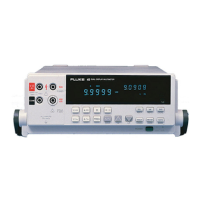Operating the Meter Using the Computer Interface
How the Meter Processes Input
5
5-7
5. Verify that the meter sends the following response
FLUKE, 45, nnnnnnn, n.n Dn.n
nnnnnnn is your meter’s serial number, n.n identifies the main software version, and Dn.n
identifies the display software version.
If Test Fails
If the meter does not respond to the test procedure as indicated:
1. Check all cable connections.
2. If you are using the RS-232 interface, check to see that the communication parameters
(e.g., baud rate, parity, etc.) on the meter and host are identical.
3. If you are using the IEEE-488, check to see that it has been properly enabled and
addressed.
How the Meter Processes Input
The following paragraphs summarize how the meter processes input that is received from a
host (or stand-alone terminal).
Note
In this manual "input "means a string sent to the meter from a host. "Output " means a
string sent from the meter through the computer interface to the host.
Input Strings
The meter processes and executes valid "input strings" sent by the host. A valid input
string is one or more syntactically correct commands followed by an "input terminator."
ASCII and IEEE-488 bus codes are provided in APPENDIX B.
When the meter receives input, it stores it in a 350-byte input buffer.
Note
Input strings received over the RS-232 interface are not executed or
checked for proper syntax until an input terminator is received or the input
buffer becomes full.
The meter accepts alphabetic characters in either upper- or lower-case. If a command
cannot be understood (i.e. the equivalent of an IEEE-488 "Command Error’,), the com-
mand and the rest of the command line are ignored.
Input Terminators
An input terminator is a character or command (IEEE-488.1) sent by the host that identi-
fies the end of an string.
In RS-232 applications, when the meter receives an input terminator it executes all com-
mands entered since the last terminator was received on a first-in first-out basis. (In
IEEE-488 applications, commands are not delayed until receipt of an input terminator,
but are executed as they are received.)
As input characters are processed and executed, space is made available in the input
buffer for new characters. In RS-232 applications, if a communications error (e.g., parity,
framing, over-run) is detected, a device-dependent error is generated, and the input string
is discarded. If the meter’s input buffer becomes full when it is used with the RS-232
interface, a device-dependent error is generated (see "Event Status and Event Status

